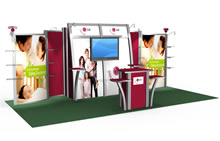
Visionary Designs VK-2034
I love the name Visionary Designs. It’s the perfect description for a trade show system that represents the cutting edge of portable/modular trade show design. Only Visionary Designs combines vibrant tension fabric graphics, durable aluminum extrusions, and elegant laminates into an unmistakable island or inline trade show exhibit. OK, enough bragging. Here are some informative FAQ’s about VD: 😉
1. What is a hybrid exhibit?
Generally, hybrid displays incorporate aluminum extrusion, tension fabric, and other display components such as laminates, wood, Sintra, and other materials to create a tabletop, inline, or island exhibit. Hybrids make liberal use of multiple components to create unique, lightweight displays.
2. What makes Visionary Designs different from your other hybrid systems, such as Perfect 10, Magellan, and Sacagawea?
With Visionary Designs, anything is possible – portable, modular, custom, and custom-hybrid designs. Visionary Designs can be any size, any shape, any configuration. Think of the display kits as idea generators rather than final designs.
Sacagawea blends upscale design with aggressive pricing that’s perfect for anyone looking for a lightweight hybrid display. Choose from three attractive design series, 65 compact and versatile displays, and terrific 10 ft. and 20 ft. configurations with multiple options.
Anyone who loves curves, loves Magellan because the kits are all about curved metal and large tension fabric graphics. The most popular have been the Miracle and MOR, which (not surprisingly) are also the most affordable.
Perfect 10 assembles without tools and comes in a mind-boggling assortment of color and shape options, all included in the standard price.There’s no other display like Perfect 10, because not other system has the patented Perfect 10 S-Shape.
3. What are the key features of Visionary Designs?
- Sizes: Table Tops, Inlines, Islands, Counters, Pedestals, and Workstations
- Kits: Over 300 standard kits. Unlimited design opportunities.
- Aluminum Extrusions: Hundreds: Depends on the design and the function.
- Graphics: From one to multiple tension fabric and direct print graphics. Velcro and silicone edge tension fabric connections.
- Assembly: Hex key assembly. Individual numbered parts with detailed setup instructions.
- Colors: Standard Sintra/Plex colors. (1) Standard extrusion color: Silver (clear satin anodized). Powder coat and anodizing options available for an additional cost.
- Packaging: Roto-molded cases, tubs, and jigged wood crates.
Bottom Line: Extensive extrusion options, hex key assembly, small, medium, and large graphics (including SEG), unlimited designs, inlines, islands, and table tops. Visionary Designs includes the new SEGUE line of Silicone Edge Graphic displays, which maximizes graphics and minimizes visible extrusion.
4. What is a tension fabric graphic?
Tension fabric graphics attach to a frame so the fabric is taut edge-to-edge, creating “tension.” Typically, the graphic has Velcro hook sewn along the border, usually top and bottom, and attaches to Velcro loop on the frame. A silicone bead or welting can also be sewn to the edge of the tension fabric graphic. Those are referred to as Silicone Edge Graphics(SEG).
What are the benefits of fabric graphics vs. traditional first surface graphics?
- Flexibility. An array of fabric options and finishing exists. Fabric graphics can be adapted to just about any hardware
- Storage and Shipping. Fabric is lighter than many other graphics. Fold your graphics neatly when in storage and take up much less space.
- Care. Fabric graphics can be washed and steamed and are just as durable and long lasting as traditional graphics.
- Lightweight. Larger graphics weigh less, perfect for draping or creating space definition.
- Cost. More image bang for the buck!
- Green. There are the obvious transportation and storage benefits. Even more exciting is the growing list of fabric options created from recycled materials.
- No Glare. Fabric is the perfect choice for media walls or any backdrop that is being photographed or filmed.
- Versatility. Fabric can be applied to most display and hardware options and is perfect for skinning or covering displays or objects. Custom covers can be created to drape over objects, wrap, or completely pillowcase them!
5. I see the product name “SEGUE” in the Visionary Designs gallery? What is a SEGUE display?
SEGUE is a sub-category of Visionary Designs Hybrid Exhibits. All SEGUE displays are designed with TSP aluminum extrusions which accept Silicone Edge Graphics. Silicone Edge Graphics (or SEG) is a high-resolution dye-sublimated fabric graphic finished with a thin silicone strip (or welt/gasket). The silicone strip is sewn directly to the edge of the graphic, and the strip is then inserted into an aluminum frame with a recessed groove.
The goal of a SEGUE design, unlike other hybrid designs, is to minimize the appearance of aluminum extrusion. In most SEGUE designs, you see far less aluminum extrusion than if the display was built using traditional alumunum profiles. Good examples of SEGUE designs include:
VK-1309 | VK-1314 | VK-2306 | VK-2302 | DM-0621 |
MOD-1259 | DM-0636 | DM-0634 | DM-0588 | DM-0580 |
Next, Euro LT Modular Laminate Exhibits








